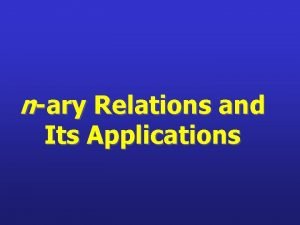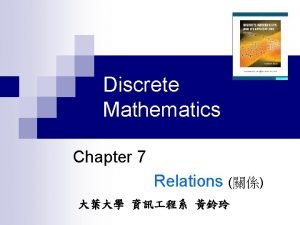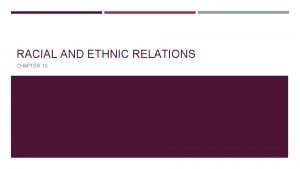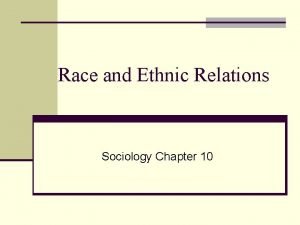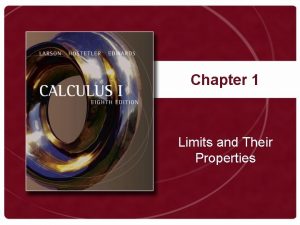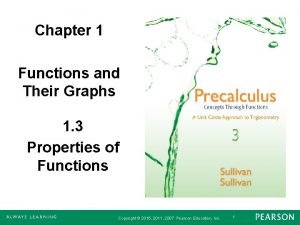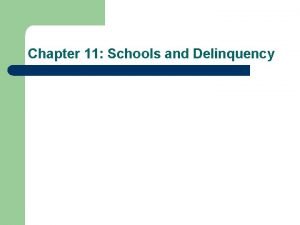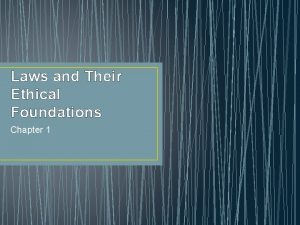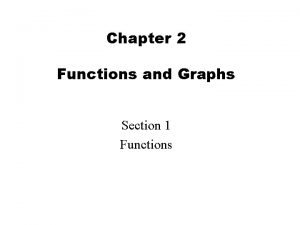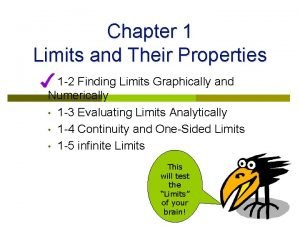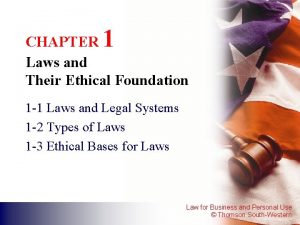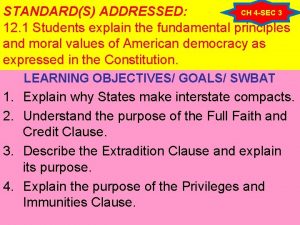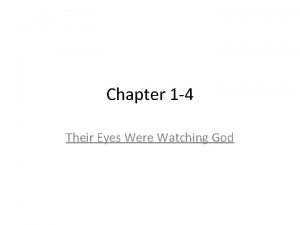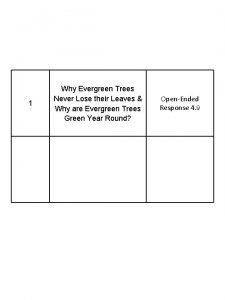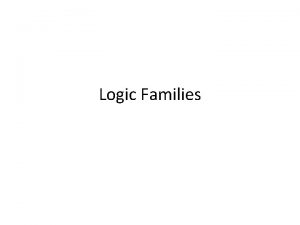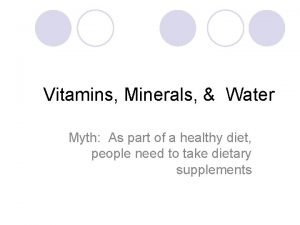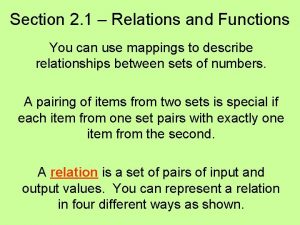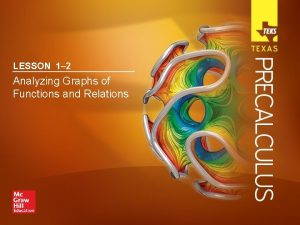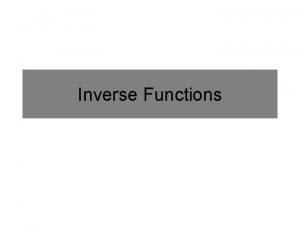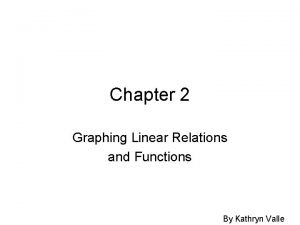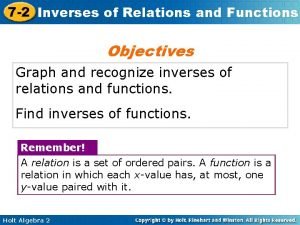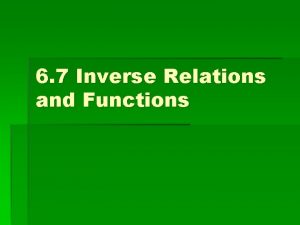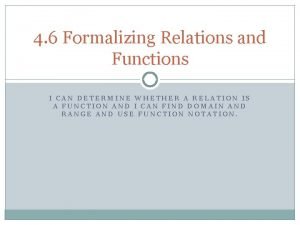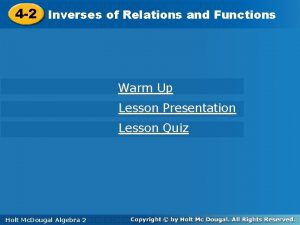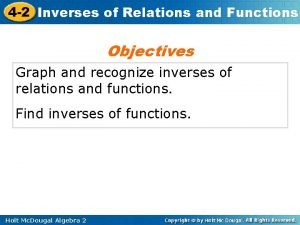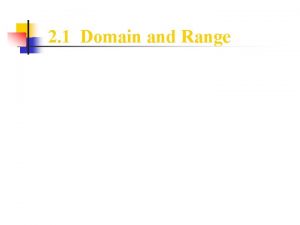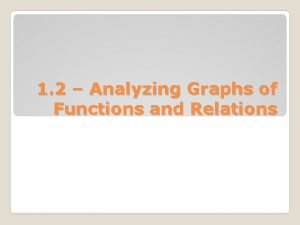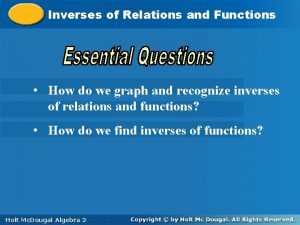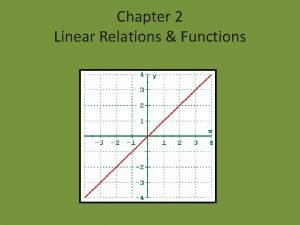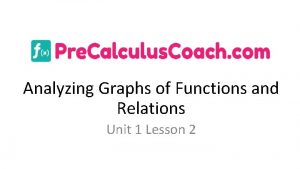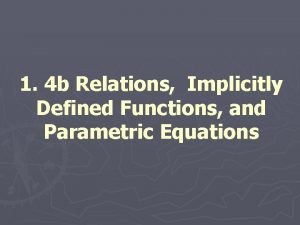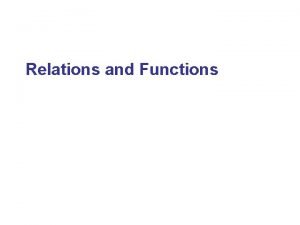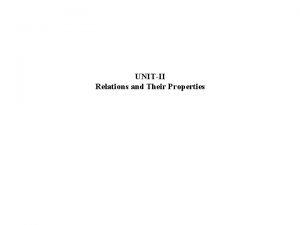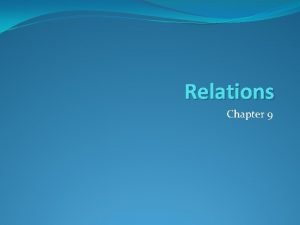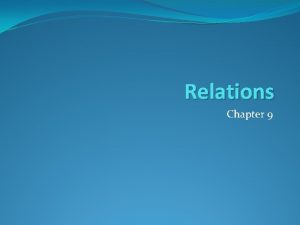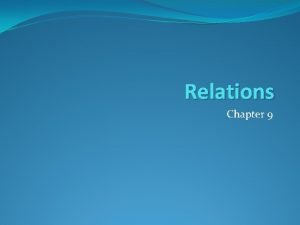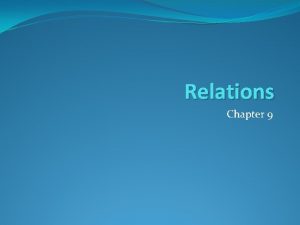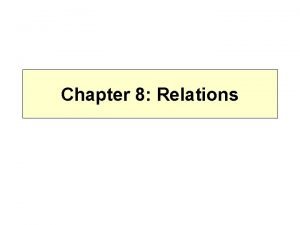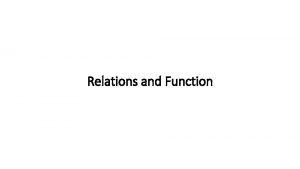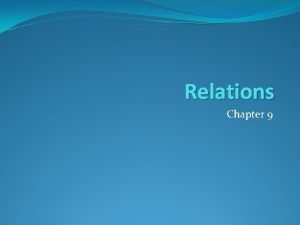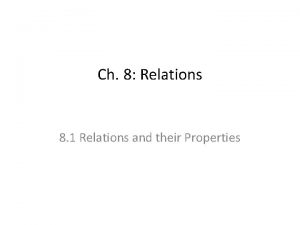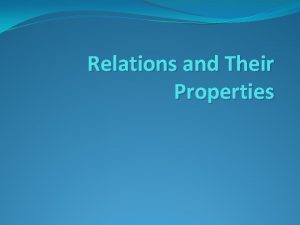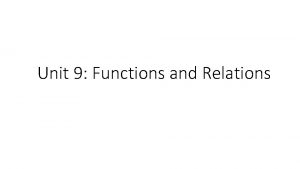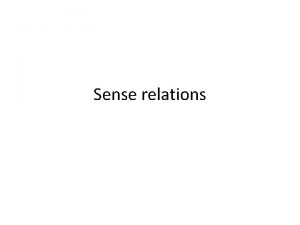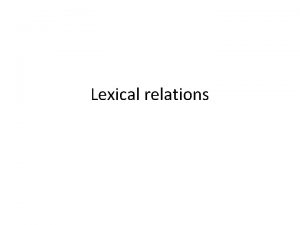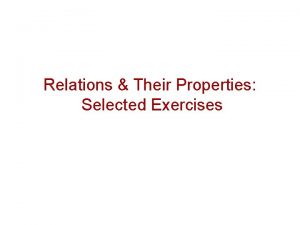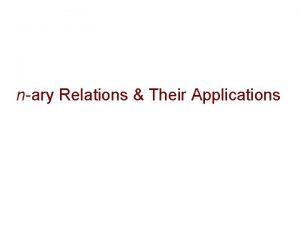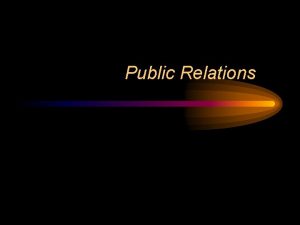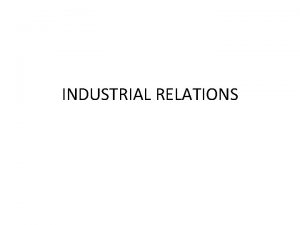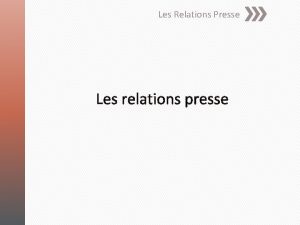Chapter 8 Relations 8 1 Relations and Their

































































- Slides: 65

Chapter 8: Relations

8. 1 Relations and Their Properties Binary relations: • Let A and B be any two sets. • A binary relation R from A to B, written R : A B, is a subset of the Cartesian product A×B. • The notation a R b means (a, b) R. • If a R b we may say that a is related to b (by relation R ), or a relates to b (under relation R ).

Example Let R : A B, and A = {1, 2, 3} represents students, B = {a, b} represents courses. A×B = { (1, a), (1, b), (2, a), (2, b), (3, a), (3, b)}. If R = {(1, a), (1, b)}, it means that student 1 registered in courses a and b

Relations can be Represented by: Let A be the set {1, 2, 3, 4} for which ordered pairs are in the relation R = {(a, b) | a divides b} A- Roaster Notation: List of ordered pairs: R = {(1, 1), (2, 2), (3, 3), (4, 4), (1, 2), (1, 3), (1, 4), (2, 4)} B- Set builder notation: R = {(a, b) : a divides b}

Relations can be Represented by: C- Graph: R = {(1, 1), (2, 2), (3, 3), (4, 4), (1, 2), (1, 3), (1, 4), (2, 4)} 1 1 2 2 3 3 4 4 OR Domain of R 1 2 3 4

Relations can be Represented by: D- Table: R = {(1, 1), (2, 2), (3, 3), (4, 4), (1, 2), (1, 3), (1, 4), (2, 4)} R 1 2 3 4 1 × × 2 3 4 × ×

Relations on a Set • A (binary) relation from a set A to itself is called a relation on the set A. e. g. The “<” relation defined as a relation on the set N of natural numbers: let < : N N : ≡ {(a, b) | a < b } If (a, b) R then a < b means (a, b) < e. g. (1, 2) <.

Relations on a Set Examples: Consider the relations on A = {-1, 0, 1, 2}, R 1 = {(a, b) | a < b} R 2 = {(a, b) | a = b or a = -b} R 3 = {(a, b) | 0 ≤ a + b ≤ 1} R 1 = {(-1, 0), (-1, 1), (-1, 2), (0, 1), (0, 2), (1, 2)} R 2 = {(-1, -1), (0, 0), (1, 1), (2, 2), (-1, 1), (1, -1)} R 3 = {(-1, 1), (1, -1), (-1, 2), (2, -1), (0, 0), (0, 1), (1, 0)}

Relations on a Set • The identity relation IA on a set A is the set {(a, a) | a A}. e. g. If A = {1, 2, 3, 4}, then IA = {(1, 1), (2, 2), (3, 3), (4, 4)}.

Question How many relations are there on a set with n elements? Answer: 1. A relation on set A is a subset from A×A. 2. A has n elements so A×A has n 2 elements. 3. Number of subsets for n 2 elements is , thus there are relations on a set with n elements. e. g. If S = {a, b, c}, there are relations.

Properties of Relations 1. Reflexivity and Irreflexivity A relation R on A is reflexive if (a, a) R for every element a A. e. g. Consider the following relations on {1, 2, 3, 4} R 1 = {(1, 1), (1, 2), (2, 1), (2, 2), (3, 4), (4, 1), (4, 4)}, Not Reflexive. R 2 = {(1, 1), (2, 2), (3, 3), (3, 4), (4, 4)}, Reflexive. R 3 = {(a, b) | a ≤ b}, Reflexive.

Reflexivity and Irreflexivity A relation R on A is irreflexive if for every element a A, (a, a) R. Note: “irreflexive” ≠ “not reflexive”. e. g. If A = {1, 2}, R = {(1, 2), (2, 1), (1, 1)} is not reflexive because (2, 2) R, not irrflexive because (1, 1) R.

Example 1 2 3 4 Not Reflexive and Not Irreflexive

Examples 1 2 3 4 Irreflexive Reflexive

2. Symmetry and Antisymmetry • A binary relation R on A is symmetric if (a, b) R ↔ (b, a) R, where a, b A. • A binary relation R on A is antisymmetric if (a, b) R → (b, a) R. That is, if (a, b) R (b, a) R → a = b.

Examples Consider these relations on the set of integers: R 1 = {(a, b) | a = b} Symmetric , antisymmetric. R 2 = {(a, b) | a > b}, Not symmetric, antisymmetric. R 3 = {(a, b) | a = b + 1}, Not symmetric, antisymmetric.

Examples Let A = {1, 2, 3}. R 1 = {(1, 2), (2, 2), (3, 1), (1, 3)} Not reflexive, not irreflexive, not symmetric, not antisymmetric R 2 = {(2, 2), (1, 3), (3, 2)} Not reflexive, not irreflexive, not symmetric, antisymmetric R 3 = {(1, 1), (2, 2), (3, 3)} Reflexive, not irreflexive, symmetric, antisymmetric R 4 = {(2, 3)} Not reflexive, irreflexive, not symmetric, antisymmetric

3. Transitivity • A relation R is said to be transitive if and only if (for all a, b, c), (a, b) R (b, c) R → (a, c) R. e. g. Let A = {1, 2}. R 1 = {(1, 1), (1, 2), (2, 1), (2, 2)} is transitive. R 2 = {(1, 1), (1, 2), (2, 1)} is not transitive, (2, 2) R 2. R 3 = {(3, 4)} is transitive.

Special Cases Empty set { } Irreflexive, transitive, symmetric, antisymmetric. Universal set U Reflexive, transitive, symmetric.

Combining Relations Let A = {1, 2, 3} , B = {1, 2, 3, 4}, R 1 = {(1, 1), (2, 2), (3, 3)}, R 2 = {(1, 1), (1, 2), (1, 3), (1, 4)}, then R 1 R 2 = {(1, 1), (2, 2), (3, 3), (1, 2), (1, 3), (1, 4)} R 1 R 2 = {(1, 1)} R 1 − R 2 = {(2, 2), (3, 3)}

Composite Relations • If (a, c) is in R 1 and (c, b) is in R 2 then (a, b) is in R 2◦R 1. e. g. R is the relation from {1, 2, 3} to {1, 2, 3, 4} R = {(1, 1), (1, 4), (2, 3), (3, 1), (3, 4)}. S is the relation from {1, 2, 3, 4} to {0, 1, 2} S = {(1, 0), (2, 0), (3, 1), (3, 2), (4, 1)}. S◦R = {(1, 0), (1, 1), (2, 2), (3, 0), (3, 1)}.

Powers • Let R be a relation on the set A. the power Rn, n = 1, 2, 3, … are defined by R 1 = R and Rn = Rn -1 ◦ R e. g. Let R = {(1, 1), (2, 1), (3, 2), (4, 3)}. Find R 2 =R ◦ R = {(1, 1), (2, 1), (3, 1), (4, 2)} R 3 = R 2 ◦ R = {(1, 1), (2, 1), (3, 1), (4, 1)}

8. 3 Representing Relations • Some special ways to represent binary relations: – With a zero-one matrix. – With a directed graph.

Using Zero-One Matrices • To represent a relation R by a matrix MR = [mij ], let mij = 1 if (ai , bj) R, otherwise 0. e. g. , Joe likes Susan and Mary, Fred likes Mary, and Mark likes Sally. • The 0 -1 matrix representation of that relation:

Example Let A = {1, 2, 3} , B = {1, 2} , R : A → B such that: R = {(2, 1), (3, 2)} then the matrix for R is: 1 1 2 3 2

Zero-One Reflexive, Symmetric The terms: Reflexive, non-reflexive, irreflexive, symmetric and antisymmetric. – These relation characteristics are very easy to recognize by inspection of the zero-one matrix. anything Symmetric: all identical across diagonal Antisymmetric: all 1’s are across from 0’s g in h yt an anything Reflexive: all 1’s on diagonal anything Irreflexive: all 0’s on diagonal

Example Is R reflexive, symmetric, antisymmetric? Reflexive, symmetric, not antisymmetric

Operations 1 - Union and the Intersection The Boolean Operations join and meet can be used to find the matrices representing the union and the intersection of two relations

Example Suppose R 1 and R 2 are relations on a set A which are represented by the matrices:

Operations 2 - Composite Suppose that R : A ↔ B, S : B ↔ C (Boolean Product)

Example Let Find the matrix of ?

Operations 3 - Power

Example • Find the matrix that represents R 2 where the matrix representing R is:

Using Directed Graphs A directed graph or digraph G = (VG , EG) is a set VG of vertices (nodes) with a set EG VG ×VG of edges (arcs or links). Visually represented using dots for nodes, and arrows for edges. Notice that a relation R : A ↔ B can be represented as a graph GR = (VG = A B, EG = R). MR GR Edge set EG (blue arrows) Joe Fred Mark Susan Mary Sally Node set VG (black dots)

Digraph Reflexive, Symmetric It is extremely easy to recognize the reflexive, irreflexive, symmetric, antisymmetric properties by graph inspection. Reflexive: Every node has a self-loop Irreflexive: No node links to itself Not symmetric, non-antisymmetric Symmetric: Every link is bidirectional Antisymmetric: No link is bidirectional Non-reflexive, non-irreflexive

8. 4 Closures of Relations • For any property X, the “X closure” of a set A is defined as the “smallest” superset of A that has the given property. • The reflexive closure of a relation R on A is obtained by adding (a, a) to R for each a A not already in R. i. e. It is R IA.

Example 1 The relation R = {(1, 1), (1, 2), (2, 1), (3, 2)} on the set A = {1, 2, 3} is not reflexive. How can you produce a reflexive relation containing R that is as small as possible? Answer: By adding (2, 2) and (3, 3) so the reflexive closure of R is: {(1, 1), (1, 2), (2, 1), (3, 2), (2, 2), (3, 3)}.

Example 2 What is the reflexive closure of the relation: R = {(a , b) | a < b} on the set of integers? Answer: The reflexive closure of R is: {(a, b) | a < b} {(a, a) | a Z} = {(a, b) | a ≤ b}.

Symmetric Closure The symmetric closure of R is obtained by adding (b, a ) to R for each (a, b ) in R. i. e. It is R R − 1.

Example 1 The relation {(1, 1), (2, 2), (1, 2), (3, 1), (2, 3), (3, 2)} on the set {1, 2, 3} is not symmetric. How can we produce a symmetric relation that is as small as possible and contains R ? Answer: By adding (2, 1) and (1, 3) so the symmetric closure of R is: {(1, 1), (2, 2), (1, 2), (3, 1), (2, 3), (3, 2), (2, 1), (1, 3)}.

Example 2 What is the symmetric closure of the relation: R = {(a, b) | a > b} on the set of positive integers? Answer: The Symmetric Closure of R is: {(a, b) | a > b} {(b, a) | a > b} = {(a, b) | a ≠ b}.

Transitive Closure • The transitive closure or connectivity relation of R is obtained by repeatedly adding (a, c) to R for each (a, b), (b, c) in R. – i. e. It is – Or in term of zero-one matrices:


Example 2 • Find MR* for

8. 5 Equivalence Relations An equivalence relation on a set A is simply any binary relation on A that is reflexive, symmetric, and transitive. Example 1: Show that a relation on the set of real numbers R = {(a, b) | a – b is an integer}. is an equivalence relation. R is reflexive: Since a – a = 0 is an integer a R a for all a. R is symmetric: If a R b then whenever a – b is an integer b – a is an integer b R a. R is transitive: If a R b and b R c then a – b and b – c are integers, therefore, a – b + b – c = a – c is also an integer, which means a R c.

Equivalence Relations Example 2: Let R : Z Z. Show that R = {(a, b) | a ≡ b (mod m)}, m > 1 is an equivalence relation. Answer: a ≡ b (mod m) if and only if m divides a – b R is reflexive, a ≡ a (mod m) , m divides a – a = 0. R is symmetric: Suppose a ≡ b (mod m) then m divides a – b, therefore m divides –(a – b) = b – a b ≡ a (mod m). R is transitive: Suppose a ≡ b (mod m) and b ≡ c (mod m), then: m divides both a – b and b – c, therefore, m divides their sum (a – b) + (b – c) = a – c , thus a ≡ c (mod m).

Equivalence Relations Example 3: Let R be a relation on Z defined as follows: a R b if and only if 5 | (a 2 – b 2). Show that R is an equivalence relation. R is reflexive: a 2 – a 2 = 0× 5 5 | (a 2 – a 2) a R a. R is symmetric: If a R b 5 | (a 2 – b 2) a 2 – b 2 = m× 5, m Z b 2 – a 2 = (-m)× 5 5 | (b 2 – a 2) b R a. R is transitive: Suppose that a R b 5 | (a 2 – b 2) a 2 – b 2 = m× 5, m Z and b R c 5 | (b 2 – c 2) b 2 – c 2 = k× 5, k Z. Now (a 2 – b 2) + (b 2 – c 2) = (a 2 – c 2) =(m + k)× 5 5 | (a 2 – c 2) a R c.

Equivalence Classes • Let R be an equivalence relation on a set A. The set of all elements that are related to an element a of A is called the equivalence class of a. • The equivalence class of a with respect to R is denoted by [a]R. When only one relation is under consideration, we can delete the subscript R and write [a] for this equivalence class. [a]R = {s | (a, s) R }.

Equivalence Classes Example: What are the equivalence classes of 0 and 1 for congruence modulo 4? Solution: The equivalence class of 0 contains all integers a such that a ≡ 0 (mod 4). The integers in this class are those divisible by 4. Hence, the equivalence class of 0 for this relation is [0] = {. . . , -8, -4, 0, 4, 8 , . . . }. The equivalence class of 1 contains all the integers a such that a ≡ 1 (mod 4). The integers in this class are those that have a remainder of 1 when divided by 4. Hence, the equivalence class of 1 for this relation is [1] = {. . . , -7, -3, 1, 5, 9, . . . }.

Equivalence Classes and Partitions • A partition of a set S is a collection of disjoint nonempty subsets of S that have S as their union. In other words, the collection of subsets Ai , i I (where I is an index set) forms a partition of S if and only if

Equivalence Classes and Partitions Example: What are the sets in the partition of the integers arising from congruence modulo 4? Solution: There are four congruence classes, corresponding to [0]4, [1]4, [2]4, and [3]4. They are the sets [0]4 = {. . . , -8, -4, 0, 4, 8, . . . } , [1]4 = {. . . , -7, -3, 1, 5, 9, . . . } , [2]4 = {. . . , -6, -2, 2, 6, 10, . . . } , [3]4 = {. . . , -5, -1, 3, 7, 11, . . . }. These congruence classes are disjoint, and every integer is in exactly one of them. In other words, these congruence classes form a partition.

8. 6 Partial Orderings • A relation R on a set S is called a partial ordering or partial order if it is reflexive, antisymmetric, and transitive. • A set S together with a partial ordering R is called a partially ordered set, or poset, and is denoted by (S, R). Members of S are called elements of the poset.

Example 1 Show that the "greater than or equal" relation ( ) is a partial ordering on the set of integers. Solution: • a ≥ a for every integer a, ≥ is reflexive. • If a ≥ b and b ≥ a, then a = b. Hence, ≥ is antisymmetric. • Finally, ≥ is transitive because a ≥ b and b ≥ c imply that a ≥ c. It follows that ≥ is a partial ordering on the set of integers and (Z, ≥) is a poset.

Example 2 Show that the divisibility relation “|“ is a partial ordering on the set of positive integers Z+. Solution: • a | a for every positive integer a, | is reflexive. • If a | b and b | a, then a = b, | is antisymmetric. • Finally, | is transitive because a | b and b | c imply that a | c. We see that (Z+ , |) is a poset.

Definition The elements a and b of a poset (S, ) are called comparable if either a b or b a. When a and b are elements of S such that neither a b nor b a, a and b are called incomparable. Example: In the poset (Z+, |), The integers 3 and 9 are comparable because 3 | 9. The integers 5 and 7 are incomparable, because 5 | 7 and 7 | 5.

Definition If (S, ) is a poset and every two elements of S are comparable, S is called a totally ordered or linearly ordered set, and is called a total order or a linear order. A totally ordered set is also called a chain. Example 1: The poset (Z, ≤) is totally ordered, because a ≤ b or b ≤ a whenever a and b are integers. Example 2: The poset (Z+, |) is not totally ordered because it contains elements that are incomparable, such as 5 and 7.

Hasse Diagrams We can represent a partial ordering on a finite set using this procedure: • Start with the directed graph for this relation. Because a partial ordering is reflexive, a loop is present at every vertex. Remove these loops. • Remove all edges that must be in the partial ordering because of the presence of other edges and transitivity. For instance, if (a, b) and (b, c) are in the partial ordering, remove the edge (a, c), because it must be present also. Furthermore, if (c, d) is also in the partial ordering, remove the edge (a, d), because it must be present also. • Finally, arrange each edge so that its initial vertex is below its terminal vertex (as it is drawn on paper). Remove all the arrows on the directed edges, because all edges point "upward" toward their terminal vertex. (The edges left correspond to pairs in the covering relation of the poset.

Example 1 Constructing the Hasse Diagram for ({ 1, 2, 3, 4 }, ≤).

Example 1 Let A = {a, b, c}. Constructing the Hasse Diagram for (P(A), ). P(A) = { , {a}, {b}, {c}, {a, b}, {a, c}, {b, c}, {a, b, c}} {a, b, c} {a, b} {a, c} {b} {b, c} {c}

Maximal and Minimal Elements • Elements of posets that have certain extremal properties are important for many applications. • An element of a poset is called maximal if it is not less than any element of the poset. That is, a is maximal in the poset (S, ) if there is no b S such that a b. Similarly, an element of a poset is called minimal if it is not greater than any element of the poset. That is, a is minimal if there is no element b S such that b a. Maximal and minimal elements are easy to spot using a Hasse diagram. They are the "top" and "bottom" elements in the diagram.

Example Which elements of the Poset ({2, 4, 5 , 10, 12 , 20, 25 } , | ) are maximal, and which are minimal? Solution: Maximal elements are 12, 20 and 25. Minimal elements are 2 and 5. The Hasse Diagram of the Poset. This example shows that a poset can have more than one maximal element and more than one minimal element.

Greatest Element and Least Element • We say that a is the greatest element of the poset (S, ) if b a for all b S. The greatest element is unique when it exists. • Also, a is siad the least element of the poset (S, ) if a b for all b S. The least element is unique when it exists.

Example Determine whether the posets represented by each of the Hasse diagrams in the Figure have a greatest element and/or a least element. Answer: (a) No greatest element, a is the least element. (b) No greatest element, no least element. (c) d is the greatest element, no least element. (d) d is the greatest element, a is the least element.

Example If A is a subset of the poset (S, ) and u is an element of S such that a u for all elements a A, then u is called an upper bound of A. The element x is called the least upper bound of the subset A if x is an upper bound that is less than every other upper bound of A. If l is an element of S such that I a for all elements a A, then I is called a lower bound of A. The element y is called greatest lower bound of A if y is a lower bound of A and z y whenever z is a lower bound of A. The greatest lower bound and least upper bound of a subset A are denoted by glb(A) and lub(A), respectively.

Example Consider the poset ({2, 4, 5 , 10, 12 , 20, 25 } , | ). Find the lower and upper bounds of A = {2, 4}. Find the glb(A) and lub(A). Solution: The lower bound of A is 2. The upper bound of A is 4, 12 and 20. The glb(A) is 2. The lub(A) is 4. The Hasse Diagram of the Poset.
 N-ary relation
N-ary relation Relations and their properties
Relations and their properties Relations and their properties
Relations and their properties Relations and their properties
Relations and their properties Employee relations in public relations
Employee relations in public relations In fair verona where we lay our scene modern translation
In fair verona where we lay our scene modern translation Chapter 10 racial and ethnic relations
Chapter 10 racial and ethnic relations Chapter 10 racial and ethnic relations
Chapter 10 racial and ethnic relations Chapter 10 racial and ethnic relations review worksheet
Chapter 10 racial and ethnic relations review worksheet Arthropods characteristics
Arthropods characteristics Chapter 2 principles of ecology
Chapter 2 principles of ecology Chapter 2 section 1 organisms and their relationships
Chapter 2 section 1 organisms and their relationships Principles of ecology section 3 cycling of matter
Principles of ecology section 3 cycling of matter Principles of ecology chapter 2
Principles of ecology chapter 2 Chapter 18 genomes and their evolution
Chapter 18 genomes and their evolution Overview elements and their properties answer key
Overview elements and their properties answer key Chapter 1 limits and their properties
Chapter 1 limits and their properties Chapter 1 functions and their graphs
Chapter 1 functions and their graphs Chapter 11 school policies and their functions
Chapter 11 school policies and their functions Chapter 1 laws and their ethical foundation
Chapter 1 laws and their ethical foundation Chapter 2 functions and their graphs answers
Chapter 2 functions and their graphs answers Chapter 1 limits and their properties
Chapter 1 limits and their properties Limits and their properties chapter 1 answers
Limits and their properties chapter 1 answers Chapter 17 overview elements and their properties
Chapter 17 overview elements and their properties Chapter 2 section 1 organisms and their relationships
Chapter 2 section 1 organisms and their relationships Atlantic revolutions and their echoes
Atlantic revolutions and their echoes Chapter 1 laws and their ethical foundation
Chapter 1 laws and their ethical foundation Chapter 4 section 3 interstate relations answer key
Chapter 4 section 3 interstate relations answer key Interstate relations chapter 4 section 3
Interstate relations chapter 4 section 3 Their eyes were watching god chapter 19-20 summary
Their eyes were watching god chapter 19-20 summary Their eyes were watching god chapter 2 summary
Their eyes were watching god chapter 2 summary Their eyes were watching god ch 7 summary
Their eyes were watching god ch 7 summary Their eyes were watching god chapter 12 summary
Their eyes were watching god chapter 12 summary Their eyes were watching god chapter 8 summary
Their eyes were watching god chapter 8 summary Chapter 13 summary their eyes were watching god
Chapter 13 summary their eyes were watching god Tewwg chapter 4
Tewwg chapter 4 Tewwg chapter 9 summary
Tewwg chapter 9 summary Why the evergreen trees never lose their leaves
Why the evergreen trees never lose their leaves Their eyes were watching god chapter 10-12 summary
Their eyes were watching god chapter 10-12 summary Ttl and cmos logic families and their characteristics
Ttl and cmos logic families and their characteristics What is the useful and harmful materials
What is the useful and harmful materials What are theological and cardinal virtues?
What are theological and cardinal virtues? Minerals sources functions and deficiency chart
Minerals sources functions and deficiency chart Macronutrients elements
Macronutrients elements Function rules examples
Function rules examples Analyzing graphs of functions and relations
Analyzing graphs of functions and relations Horizontal line test
Horizontal line test Introduction to pr
Introduction to pr Lesson 2-1 relations and functions
Lesson 2-1 relations and functions Advantages and disadvantages of public relations
Advantages and disadvantages of public relations Sales promotion and public relations
Sales promotion and public relations Inverse functions notes
Inverse functions notes 6-7 inverse relations and functions
6-7 inverse relations and functions Unit 5 lesson 6 formalizing relations and functions
Unit 5 lesson 6 formalizing relations and functions Lesson 6-2 graphs of inverse functions
Lesson 6-2 graphs of inverse functions 4-2 inverses of relations and functions
4-2 inverses of relations and functions Domain and range
Domain and range 1-2 analyzing graphs of functions and relations
1-2 analyzing graphs of functions and relations Produk kartesius
Produk kartesius 4-2 practice b inverses of relations and functions
4-2 practice b inverses of relations and functions Characteristics of relations and functions
Characteristics of relations and functions Public relations sales promotion
Public relations sales promotion Analyzing graphs of functions
Analyzing graphs of functions Implicit function grapher
Implicit function grapher Politics and international relations bsc
Politics and international relations bsc Function vs relation
Function vs relation
